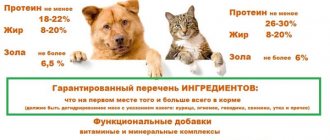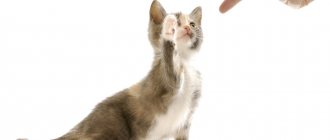The cat is a favorite pet of many people. Cats not only distract you from constant daily problems, relax, and improve not only your physical condition, but also your emotional one.
Many people get cats not for exhibitions, but simply for the soul. If you decide to seriously engage in cat breeding, you need to know about the classes of cats.
Classes according to the WCF system
The assessment of a pet is carried out during the examination of the animal by an expert, based on comparison with other animals and in accordance with the breed, sex, color and evaluation class:
- First class includes World Champions, competing for the title of "Best in Show" and "Winner of Breed";
- the second class includes world premiers, competing for the titles indicated in the first class among castrated animals;
- the third class includes cats competing for the title of "World Champion", "Best in Show" or "Winner of Breed";
- the fourth class is represented by the Grand European Premiers, competing for the title of "World Premier";
- the fifth class is represented by European Champions, competing for the titles of “European Grand Champion”, “Winner of Breed” and “Best in Show”;
- the sixth class is represented by European Premiers, competing for the title of “European Grand Champion”;
- the seventh class is represented by Grand International Champions competing for the title of “European Champion”;
- the eighth grade is represented by the Grand International Premiers, competing for the title of "European Premier";
- the ninth class is represented by International Champions competing for the title of “International Grand Champion”;
- the tenth class is represented by International Premiers, competing for the title of "International Grand Premier";
- the eleventh class is represented by Champions competing for the title of “International Champion”;
- the twelfth class is represented by Premiers competing for the title of “International Premier”;
- the open thirteenth class is represented by breeding animals older than ten months, having documents that confirm their origin or having passed through classes, competing for the title “Champion”;
- the fourteenth class is represented by castrated animals over ten months old, competing for the title "Premier";
- the fifteenth class is represented by animals aged from six months to ten months, competing for the title of “Breed Winner among Young Animals” or “Best in Show among Young Animals”;
- The sixteenth class is represented by animals aged from three months to six months, competing for the title “Breed Winner among Kittens” or “Best in Show among Kittens”
- the seventeenth litter class is represented by animals aged from ten weeks to three months, competing for the title of “Best Litter”;
- in the eighteenth grade, beginners are exhibited for at least six months, and upon receiving an “excellent” rating, the animal is registered in the breed;
- in the nineteenth grade, the color of three-month-old kittens is determined without making a grade.
In the twentieth class, domestic spayed cats and neutered cats older than six months are exhibited, competing for the title “Best Domestic Cat” or “Best Domestic Cat”.
Blog about cats
Let's determine what classes of animals there are.
SHOW-CLASS – these animals have outstanding breed characteristics and compete for first prizes at exhibitions. BREED-CLASS – these animals have standard breed characteristics and are rated “excellent” at exhibitions. PET-CLASS – these animals are not standard or have defects and pronounced shortcomings of the breed.
Let's assume that pet-class can be distinguished from show and breed-class, all the vices and shortcomings are obvious there. At the same time, show from breed-class can be difficult to distinguish even for an experienced specialist, especially at an early age. Here, as a rule, they rely on the outstanding breed characteristics of the parents and breed the best cat with the best male. However, it is no secret that this method in selection is called artificial prepotency (when the best is matched to the best). This is not a guarantee that all kittens in the litter will be show-class; there may well be breed-class and even pet-class. It’s a completely different matter if a prepotent show-class producer takes part in the breeding work, which significantly improves the quality of the kittens. After all, the cat’s task is to improve the quality of the cat. Therefore, from such a manufacturer and from a cat, for example, breed-class, kittens of both show and breed-class may well appear. However, the most outstanding results can be observed from the mating of two inbred animals. If felinologists have made the calculation correctly, then such combinations can produce individuals much better than their parents. This improves the quality of the breed.
So, we have established that when purchasing a show-class kitten, no one can guarantee that its breed data will not remain at the breed-class level. Therefore, the conclusion suggests itself - for breeding work, you need to purchase a kitten older than 3-4 months, and the older, the better, since the breed characteristics of the future show-class animal will stand out more clearly. Of course, now someone will object and say that not every breeder will agree to keep a kitten for so long. Yes it is! A breeder will want to sell it as early as the 1st age, but a serious breeder who is confident in the quality of the kitten on offer will never force the situation and rush to purchase, he will simply increase the cost of the animal and will keep the kitten as long as necessary. You are purchasing Show-class for targeted breeding work, so you should not rush, it is better to pay a little more, but be sure that you have a diamond of the first magnitude in your hands. There have always been few exclusive animals with outstanding breed characteristics and they still need to be found!
One of the best indicators of an animal’s quality is healthy competition at exhibitions. I would like to make it clear right away that I do not mean those exhibitions where club leaders and exhibition organizers push their animals into first place by hook or by crook. No, healthy competition is when an exhibition is organized specifically for the participants, and the organizers work for this goal and nothing more. So, at exhibitions of some European systems in the class of purebred animals there are only the first 4 prizes, the remaining participants receive “excellent” marks and are considered breed-class animals. The winner of the first place receives a rating of “excellent-1” and a title at the discretion of the expert, the rest have ratings of “excellent-2, 3, 4” and all of them belong to show-class animals, since the difference between these places with great competition may not be significant, and the opinion of each expert when assessing an animal is purely subjective. Although in fairness I should note that the higher the qualifications of the experts, the fewer discrepancies they have when assessing the animal.
So, we have established that a show-class animal can appear from parents with outstanding breed characteristics. It is better to purchase such an animal after 4 months (with prior reservation) and receiving prizes at exhibitions will confirm the class of the animal.
Breed-class kittens can appear in litters of both parents with outstanding breed characteristics and breed-class animals; this category of animals can be purchased at an earlier date, since it will not be difficult even for a beginner to distinguish breed-class from pet-class (pay attention to quality and cost). For breed-class animals, exhibition ratings of “excellent” are considered normal. However, occasionally there are cases when an animal is sold from outstanding parents as a breed-class, and it grows up to be a show-class. This is a very pleasant surprise and rather indicates the fact that it is more advisable to even acquire a breed-class from parents with outstanding breed characteristics.
We do not consider Pet-class in detail, since these are specimens for use only or, at best, for experimental breeding. I just want to note that only cats of the same group can come to a cat of experimental breeding, but cats in the experiment can have matings with breeding cats, but the litters will still be in the experimental group, regardless of the results. The pet-class variety of animals is used in the experimental group to breed any color variants, so as not to expose the breeding stock of standard animals to risks.
This is perhaps the entire gradation of classes of animals for breeding work. Few people in organizations officially stipulate classes in documents, but all animal owners secretly use the same guidelines and understand well what is at stake.
Tribal classes
All breeding classes assigned to kittens after the litter is registered at one and a half months of age must be examined by certified felinologists.
Important! It should be remembered that initially only a potential class is assigned to an animal, and the actual relationship of a pet to this class can only be confirmed by a professional expert when examining a cat or female cat at the age of ten months.
Show class animals
A conditional class of kittens that requires confirmation in the future.
This is interesting! Show-class pets must have a pronounced exterior, show character, and any shortcomings must be completely absent.
In this case, the breeder declares only the level of prospects of the kitten being sold.
Breed class animals
Kittens belonging to this class correspond to all breed qualities and characteristics, and also do not have defects and shortcomings that preclude work in breeding.
This is interesting! The Breed class is a broad group of animals with conformations ranging from simple standards to pronounced conformations.
A cat of this class gives birth to kittens of the appropriate type, easily bears and feeds its offspring. Animals of the breeding class are always adequate in mating.
Pet class animals
The class is represented by purebred kittens that have breeding defects in the form of disadvantages that preclude the use of the animal for breeding.
This is interesting! This class also includes pets that have insufficiently expressed qualities or characteristics.
Pet-class kittens, after reaching the age of ten months or a year, must be sterilized or neutered, after which they can take part in exhibition shows in the Premier class.
Show class (show-spectacular)
Show kittens have outstanding exterior qualities. At exhibitions they receive the highest marks and, of course, are most preferred by the breeder as a breeding animal.
The price for a show class will be high. However, if you decide to seriously improve the breed, or have ambitious intentions for your pet, then you will not find better representatives of this class.
Buying a show-class kitten will be a little more difficult than purchasing pet or brit-class kittens. They are born much less frequently and, as a rule, either remain in the nursery or are distributed among “their own”.
Sometimes the following situation occurs: the breeder does not have the opportunity to keep such an animal, then he sells it to the side, but at the same time certain conditions are stipulated under which its further breeding is possible.
When deciding to purchase a kitten, first decide for what purpose it is being purchased. You probably shouldn’t overpay for it if you don’t intend to participate in cat shows and don’t want to get offspring in the future.
A pet-class kitten is no worse than its titled brothers and, as a pet, it will delight its owners and delight their friends and acquaintances who are not sophisticated in the experience of an evaluator.
If the purchase of a kitten takes place in another city, this article will be useful!
Did you like the article and was it useful? Please share with your friends.
___________________________________
Other interesting articles on our website:
• Cat breeders. Is it easy to be a breeder?
• What does the color of a kitten indicate?
• Breeding cat
• Genetics of cat colors in tables with comments
- Forward >











